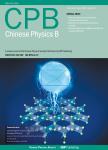Theory of phonon-modulated electron spin relaxation time based on the projection reduction method
Theory of phonon-modulated electron spin relaxation time based on the projection reduction method作者机构:Department of Applied Nanoscience Pusan National University Department of Physics Kyungpook National University
出 版 物:《Chinese Physics B》 (中国物理B(英文版))
年 卷 期:2014年第23卷第8期
页 面:436-443页
核心收录:
学科分类:07[理学] 070203[理学-原子与分子物理] 0805[工学-材料科学与工程(可授工学、理学学位)] 0704[理学-天文学] 0702[理学-物理学]
主 题:electron spin resonance spin-orbit coupling projection-reduction method phonon scattering
摘 要:This paper introduces a new method for a formula for electron spin relaxation time of a system of electrons interacting with phonons through phonon-modulated spin-orbit coupling using the projection-reduction method. The phonon absorption and emission processes as well as the photon absorption and emission processes in all electron transition processes can be explained in an organized manner, and the result can be represented in a diagram that can provide intuition for the quantum dynamics of electrons in a solid. The temperature (T) dependence of electron spin relaxation times (T1) in silicon is T1 ∝ T-1.07 at low temperatures and T1 ∝ T-3.3 at high temperatures for acoustic deformation constant Pad = 1.4 × 10^7 eV and optical deformation constant Pod = 4.0 × 10^17 eV/m. This means that electrons are scattered by the acoustic deformation phonons at low temperatures and optical deformation phonons at high temperatures, respectively. The magnetic field (B) dependence of the relaxation times is T1 ∝ B-2.7 at 100 K and T1 ∝ B-2.3 at 150 K, which nearly agree with the result of Yafet, T1 ∝ B-3.0- B -2.5.



